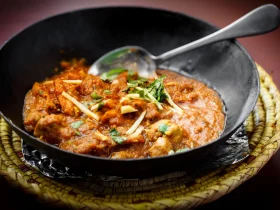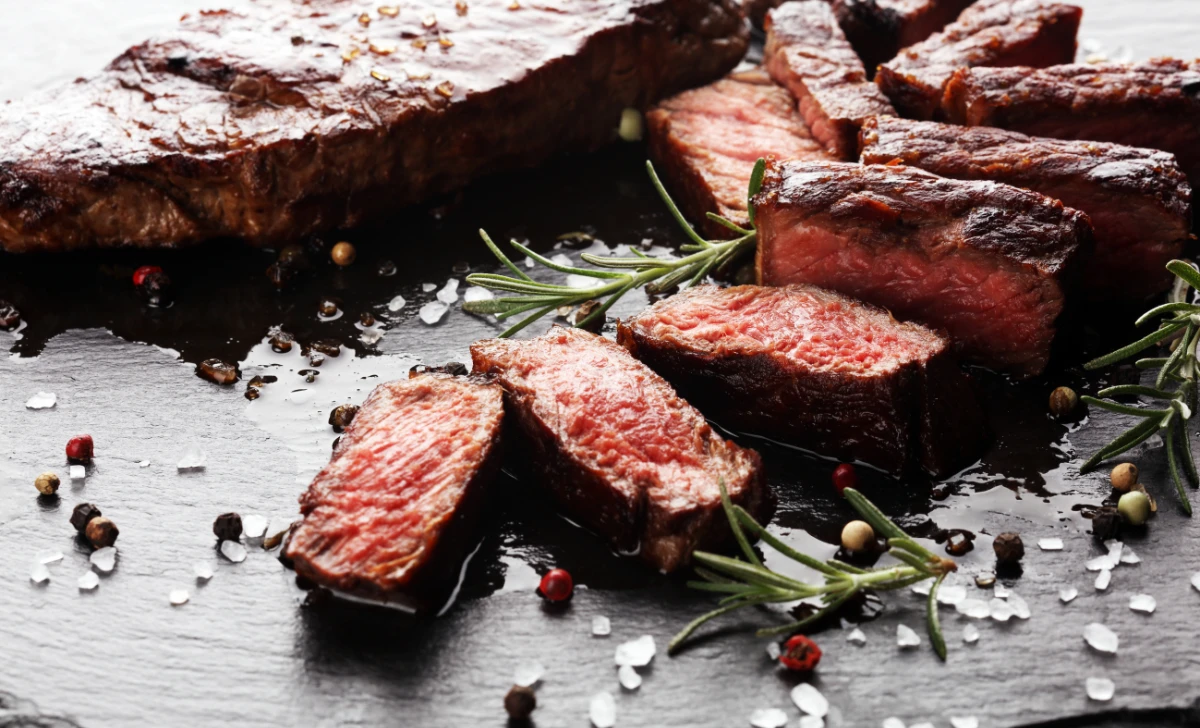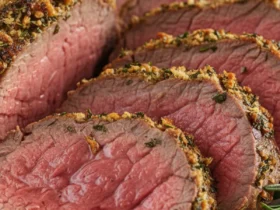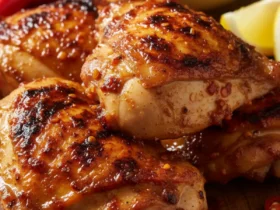Are you looking to impress your guests with a mouthwatering dish? Look no further than this tantalizing fillet steak recipe. A fillet steak, also known as tenderloin steak, is renowned for its tenderness and juiciness. With a few simple steps, you can create a gourmet meal that will leave everyone craving for more. In this article, we will guide you through the process of preparing and cooking a perfect fillet steak, ensuring a delightful culinary experience.
[ez-toc]
History
The history of the fillet steak recipe dates back to ancient times, where the consumption of meat played a vital role in human survival and culinary culture. The concept of cooking meat over an open flame has been practiced for centuries, evolving over time to include various techniques and recipes.
The origins of the fillet steak recipe can be traced back to the European culinary traditions, particularly in France, where beef tenderloin was highly prized for its tenderness and delicate flavor. It gained popularity during the reign of King Louis XV, who was known for his extravagant taste in food.
During the 19th century, the fillet steak gained further prominence in Western cuisine, with renowned chefs and restaurants showcasing their expertise in preparing this luxurious cut of meat. The emergence of fine dining establishments and the growing demand for sophisticated dishes contributed to the rise of the fillet steak’s popularity.
As time passed, the fillet steak recipe expanded its reach beyond Europe and became a staple in various international cuisines. It gained recognition in the United States during the late 19th and early 20th centuries, thanks to the influence of French culinary techniques and the growth of upscale dining establishments.
Advancements in transportation and refrigeration technology further facilitated the distribution of fillet steaks worldwide. This accessibility allowed home cooks and professional chefs alike to experiment with different cooking methods, seasonings, and accompaniments, resulting in a wide range of fillet steak recipes.
In recent years, the fillet steak recipe has undergone further evolution, with chefs incorporating modern cooking techniques and innovative flavor combinations. It has become a versatile dish that can be enjoyed on various occasions, from formal dinner parties to casual backyard grilling sessions.
Today, the fillet steak recipe continues to captivate food enthusiasts and remains a symbol of indulgence and culinary excellence. Its reputation for tenderness, juiciness, and rich flavor ensures its place as a timeless classic in the world of gastronomy.
As culinary trends continue to evolve, it is safe to say that the fillet steak recipe will continue to adapt and inspire new generations of chefs and home cooks, preserving its status as a beloved dish that never fails to delight the taste buds of meat lovers worldwide.
Time
| Step | Time (in minutes) |
|---|---|
| Choosing the Right Cut | 5 |
| Preparing the Fillet Steak | 10 |
| Marinating the Steak | 30 |
| Seasoning the Steak | 5 |
| Cooking the Fillet Steak | 12 |
| Resting the Steak | 5 |
| Total Time | 67 |
Please note that the cooking and preparation times mentioned above are approximate and may vary depending on individual cooking techniques and preferences. It is essential to adjust the timings accordingly and ensure the steak reaches your desired level of doneness.
Ingredients
| Ingredients | Quantity |
|---|---|
| Fillet steak | 2 pieces (6-8 oz each) |
| Olive oil | 2 tablespoons |
| Garlic cloves | 2 cloves |
| Fresh thyme | 2 sprigs |
| Salt | To taste |
| Black pepper | To taste |
| Butter | 2 tablespoons |
Please note that the quantities mentioned above are for a 2-person serving and can be adjusted according to your preferences and desired portion sizes.
Directions
- 1. Choosing the Right Cut
- Select high-quality fillet steaks from a reputable butcher or grocery store. Look for steaks that are well-marbled and have a vibrant red color. Aim for a thickness of around 1.5 to 2 inches for optimal cooking.
- 2. Preparing the Fillet Steak
- Remove the fillet steaks from the refrigerator and let them sit at room temperature for about 30 minutes to ensure even cooking.
- Pat the steaks dry with a paper towel to remove any excess moisture.
- 3. Marinating the Steak
- In a shallow dish, combine the olive oil, minced garlic cloves, and fresh thyme leaves.
- Place the fillet steaks in the marinade, turning them to coat evenly.
- Cover the dish with plastic wrap and let the steaks marinate in the refrigerator for at least 30 minutes, allowing the flavors to infuse.
- 4. Seasoning the Steak
- Preheat your grill or a skillet over high heat.
- Remove the fillet steaks from the marinade and discard any excess marinade.
- Season the steaks generously with salt and freshly ground black pepper on both sides, ensuring full coverage.
- 5. Cooking the Fillet Steak
- For grilling: Place the fillet steaks on the preheated grill and cook for approximately 4-5 minutes per side for medium-rare, or adjust the cooking time according to your desired level of doneness.
- For stovetop cooking: Heat a skillet over high heat and add a tablespoon of butter. Once the butter is melted and sizzling, place the fillet steaks in the skillet. Cook for about 4-5 minutes per side for medium-rare, or adjust the cooking time as per your preference.
- 6. Resting the Steak
- Once the fillet steaks are cooked to your desired level of doneness, remove them from the grill or skillet.
- Transfer the steaks to a cutting board and let them rest for about 5 minutes. This allows the juices to redistribute, resulting in a tender and juicy steak.
Equipment Required
Nutrition Information
| Nutrition Information | Amount Per Serving |
|---|---|
| Serving Size | 1 fillet steak (6-8 oz) |
| Calories | 400 |
| Total Fat | 25g |
| – Saturated Fat | 10g |
| – Trans Fat | 0g |
| Cholesterol | 120mg |
| Sodium | 400mg |
| Total Carbohydrate | 0g |
| – Dietary Fiber | 0g |
| – Sugars | 0g |
| Protein | 40g |
| Vitamin D | 1.5mcg |
| Calcium | 20mg |
| Iron | 4mg |
| Potassium | 600mg |
Please note that the nutrition information provided above is an estimate and may vary based on the specific ingredients used and the cooking methods employed. It is always advisable to refer to the nutritional labels of individual ingredients and make adjustments according to your dietary needs and preferences.
Tips
- Quality of the Steak: Choose the best quality fillet steaks you can find. Look for well-marbled steaks with a vibrant red color, as this indicates tenderness and flavor.
- Bringing Steaks to Room Temperature: Allow the fillet steaks to come to room temperature before cooking. This helps ensure even cooking throughout the steak.
- Pat Dry the Steaks: Use a paper towel to pat the steaks dry before marinating or seasoning. This step helps to remove excess moisture and allows for better browning and caramelization.
- Marinating Time: Let the steaks marinate for at least 30 minutes. This helps to enhance the flavor and tenderness of the meat. For more intense flavor, marinate the steaks for a longer period.
- Grilling vs. Stovetop: You can cook the fillet steaks either on a grill or on a stovetop skillet. Both methods can yield excellent results. Choose the method that suits your preference and available equipment.
- Cooking Time: Adjust the cooking time according to your desired level of doneness. Use a meat thermometer to check the internal temperature: 125°F (52°C) for medium-rare, 135°F (57°C) for medium, and 145°F (63°C) for medium-well.
- Resting the Steaks: After cooking, allow the fillet steaks to rest for about 5 minutes before slicing. This helps the juices redistribute throughout the meat, resulting in a more tender and flavorful steak.
Pros & Cons
| Pros | Cons |
|---|---|
| ✔️ Delivers a tender and juicy steak | ❌ High in saturated fat |
| ✔️ Impressive dish for special occasions | ❌ Requires careful cooking to avoid overcooking or undercooking |
| ✔️ Versatile recipe with room for customization | ❌ Can be an expensive cut of meat |
| ✔️ Simple and straightforward preparation | ❌ Longer marinating time may be required |
| ✔️ Delicious flavors that are sure to impress | ❌ Not suitable for vegetarian or vegan diets |
Conclusion
In conclusion, the fillet steak recipe offers a delightful culinary experience that is sure to impress both your taste buds and your guests. With its tender and juicy texture, customizable flavors, and simple preparation, this recipe is perfect for special occasions or when you want to treat yourself to a gourmet meal.
By following the step-by-step directions, you can create a mouthwatering fillet steak that will leave everyone wanting more. The careful selection of high-quality meat, the flavorful marinade, and the precise seasoning all contribute to a truly satisfying dining experience.
Whether you choose to grill your steak or cook it on the stovetop, the result will be a delicious masterpiece that showcases the natural flavors of the fillet. The combination of seared exterior and perfectly cooked interior will provide a delightful contrast that will have you savoring each and every bite.
While the recipe highlights the traditional approach, don’t be afraid to add your own personal touch. Experiment with different seasonings, herbs, or accompaniments to create a version that suits your taste preferences. The versatility of the fillet steak recipe allows for endless possibilities, ensuring a unique and enjoyable experience every time.
So, why not take a leap and try your hand at this delectable fillet steak recipe? Impress your loved ones, indulge in a culinary adventure, and savor the flavors of a perfectly cooked steak. Get ready to experience a symphony of tastes and textures that will elevate your dining experience to new heights.
Facts
- 🥩 Steak Lovers Unite! 🥩
- Did you know that fillet steak, also known as tenderloin, is considered one of the most prized cuts of beef? Its exceptional tenderness and rich flavor make it a favorite among steak enthusiasts worldwide.
- 🌍 A Global Gastronomic Journey 🌍
- The popularity of fillet steak isn’t limited to a specific region. This delectable dish has captured the hearts and taste buds of people from various culinary traditions, ranging from French cuisine to American steakhouses and beyond.
- 🍷 Perfect Pairings 🍷
- Fillet steak is often celebrated for its versatility when it comes to wine pairings. From bold and robust reds like Cabernet Sauvignon to elegant and smooth options like Pinot Noir, there’s a wine out there to complement the flavors of a perfectly cooked fillet steak.
- 🌿 Herbs and Spices Galore 🌿
- When it comes to seasoning fillet steak, the options are endless. While classic choices like salt and pepper are go-to favorites, adventurous cooks can explore an array of herbs and spices, such as rosemary, garlic, thyme, or even a touch of smoked paprika, to add their own unique twist.
- 🍽️ A Culinary Masterpiece 🍽️
- The fillet steak recipe offers not only a delightful meal but also an opportunity to showcase your culinary skills. From the art of searing to achieving the perfect doneness, each step in the process allows you to unleash your inner chef and create a culinary masterpiece.
FAQ’s
Can I use a different cut of steak for this recipe?
While fillet steak is the recommended cut for this recipe, you can use other tender cuts like ribeye or strip steak. Keep in mind that the cooking time and results may vary slightly.
Can I marinate the steaks overnight for more flavor?
Yes, marinating the steaks overnight can intensify the flavors. However, be cautious not to marinate them for too long as the meat can become mushy.
Can I cook the fillet steaks in the oven instead of grilling or using a stovetop skillet?
Yes, you can cook the fillet steaks in the oven. Preheat the oven to a high temperature and use a cast-iron skillet or oven-safe skillet for searing. Then transfer the skillet to the oven and cook to your desired level of doneness.
How do I know when the fillet steaks are done cooking?
The best way to determine the doneness of the steaks is by using a meat thermometer. For medium-rare, aim for an internal temperature of 125°F (52°C), 135°F (57°C) for medium, and 145°F (63°C) for medium-well.
Can I freeze the marinated fillet steaks for later use?
Yes, you can freeze the marinated fillet steaks. Place them in a freezer-safe bag or container and store them for up to 3 months. Thaw them in the refrigerator before cooking.
Can I substitute dried thyme for fresh thyme in the marinade?
Yes, you can substitute dried thyme for fresh thyme, but keep in mind that the flavor may be slightly different. Use approximately 1 teaspoon of dried thyme instead of the fresh sprigs.
Can I add a sauce or topping to the cooked fillet steaks?
Absolutely! You can enhance the flavors by adding a delicious sauce like peppercorn sauce, red wine reduction, or garlic butter. You can also top the steaks with sautéed mushrooms or caramelized onions for extra flavor.
Are there any recommended side dishes to serve with the fillet steaks?
Popular side dishes that pair well with fillet steaks include roasted potatoes, steamed vegetables, creamy mashed potatoes, or a fresh salad. You can also serve it with a side of crusty bread or garlic bread.
Can I adjust the seasoning to make the steaks spicy?
Absolutely! If you prefer a spicy kick, you can add a pinch of cayenne pepper or chili powder to the seasoning mix. Adjust the amount according to your spice preference.
Can I cook the fillet steaks to well-done instead of medium-rare?
Yes, if you prefer your steaks well-done, you can cook them for a longer time. Keep in mind that cooking the steaks to well-done may result in less tenderness and a slightly drier texture.












Leave a Review